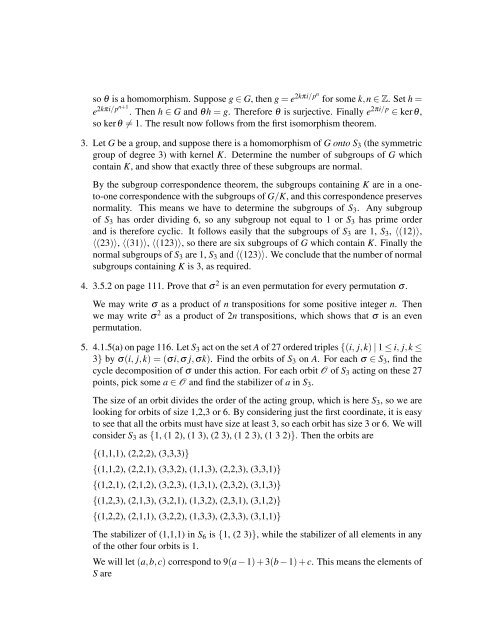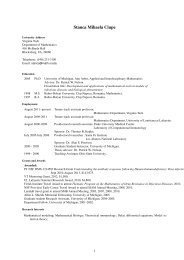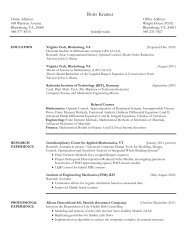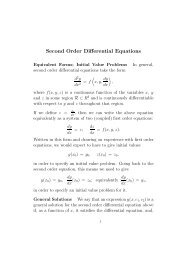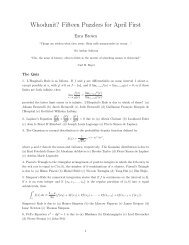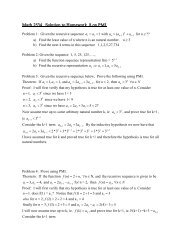Create successful ePaper yourself
Turn your PDF publications into a flip-book with our unique Google optimized e-Paper software.
so θ is a homomorphism. Suppose g ∈ G, then g = e2kπi/pn for some k,n ∈ Z. Set h =<br />
e2kπi/pn+1. Then h ∈ G and θh = g. Therefore θ is surjective. Finally e2πi/p ∈ kerθ,<br />
so kerθ �= 1. The result now follows from the first isomorphism theorem.<br />
3. Let G be a group, and suppose there is a homomorphism of G onto S3 (the symmetric<br />
group of degree 3) with kernel K. Determine the number of subgroups of G which<br />
contain K, and show that exactly three of these subgroups are normal.<br />
By the subgroup correspondence theorem, the subgroups containing K are in a oneto-one<br />
correspondence with the subgroups of G/K, and this correspondence preserves<br />
normality. This means we have to determine the subgroups of S3. Any subgroup<br />
of S3 has order dividing 6, so any subgroup not equal to 1 or S3 has prime order<br />
and is therefore cyclic. It follows easily that the subgroups of S3 are 1, S3, 〈(12)〉,<br />
〈(23)〉, 〈(31)〉, 〈(123)〉, so there are six subgroups of G which contain K. Finally the<br />
normal subgroups of S3 are 1, S3 and 〈(123)〉. We conclude that the number of normal<br />
subgroups containing K is 3, as required.<br />
4. 3.5.2 on page 111. Prove that σ 2 is an even permutation for every permutation σ.<br />
We may write σ as a product of n transpositions for some positive integer n. Then<br />
we may write σ 2 as a product of 2n transpositions, which shows that σ is an even<br />
permutation.<br />
5. 4.1.5(a) on page 116. Let S3 act on the set A of 27 ordered triples {(i, j,k) | 1 ≤ i, j,k ≤<br />
3} by σ(i, j,k) = (σi,σ j,σk). Find the orbits of S3 on A. For each σ ∈ S3, find the<br />
cycle decomposition of σ under this action. For each orbit O of S3 acting on these 27<br />
points, pick some a ∈ O and find the stabilizer of a in S3.<br />
The size of an orbit divides the order of the acting group, which is here S3, so we are<br />
looking for orbits of size 1,2,3 or 6. By considering just the first coordinate, it is easy<br />
to see that all the orbits must have size at least 3, so each orbit has size 3 or 6. We will<br />
consider S3 as {1, (1 2), (1 3), (2 3), (1 2 3), (1 3 2)}. Then the orbits are<br />
{(1,1,1), (2,2,2), (3,3,3)}<br />
{(1,1,2), (2,2,1), (3,3,2), (1,1,3), (2,2,3), (3,3,1)}<br />
{(1,2,1), (2,1,2), (3,2,3), (1,3,1), (2,3,2), (3,1,3)}<br />
{(1,2,3), (2,1,3), (3,2,1), (1,3,2), (2,3,1), (3,1,2)}<br />
{(1,2,2), (2,1,1), (3,2,2), (1,3,3), (2,3,3), (3,1,1)}<br />
The stabilizer of (1,1,1) in S6 is {1, (2 3)}, while the stabilizer of all elements in any<br />
of the other four orbits is 1.<br />
We will let (a,b,c) correspond to 9(a − 1) + 3(b − 1) + c. This means the elements of<br />
S are


